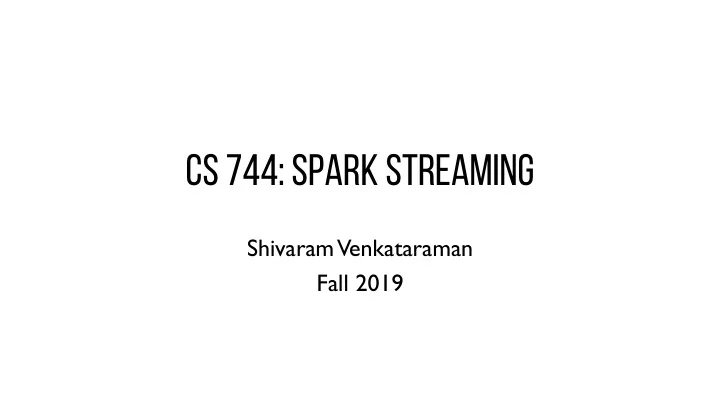

CS 744: SPARK STREAMING Shivaram Venkataraman Fall 2019
ADMINISTRIVIA - Midterm grades this week - Course Projects sign up for meetings
Applications Machine Learning SQL Streaming Graph Computational Engines Scalable Storage Systems Resource Management Datacenter Architecture
CONTINUOUS OPERATOR MODEL Long-lived operators Mutable State Distributed Checkpoints for Fault Recovery Stragglers ? Driver Control Message Naiad Network Transfer Task
CONTINUOUS OPERATORS
SPARK STREAMING: GOALS 1. Scalability to hundreds of nodes 2. Minimal cost beyond base processing (no replication) 3. Second-scale latency 4. Second-scale recovery from faults and stragglers
DISCRETIZED STREAMS (DSTREAMS)
EXAMPLE pageViews = readStream(http://..., "1s") ones = pageViews.map( event =>(event.url, 1)) counts = ones.runningReduce( (a, b) => a + b)
ARCHITECHTURE
DSTREAM API Transformations Stateless: map, reduce, groupBy, join Stateful: window(“5s”) à RDDs with data in [0,5), [1,6), [2,7) reduceByWindow(“5s”, (a, b) => a + b)
SLIDING WINDOW Add previous 5 each time
STATE MANAGEMENT Tracking State: streams of (Key, Event) à (Key, State) events.track( (key, ev) => 1, (key, st, ev) => ev == Exit ? null : 1, "30s”)
SYSTEM IMPLEMENTATION
OPTIMIZATIONS Timestep Pipelining No barrier across timesteps unless needed Tasks from the next timestep scheduled before current finishes Checkpointing Async I/O, as RDDs are immutable Forget lineage after checkpoint
FAULT TOLERANCE: PARALLEL RECOVERY Worker failure - Need to recompute state RDDs stored on worker - Re-execute tasks running on the worker Strategy - Run all independent recovery tasks in parallel - Parallelism from partitions in timestep and across timesteps
EXAMPLE pageViews = readStream(http://..., "1s") ones = pageViews.map( event =>(event.url, 1)) counts = ones.runningReduce( (a, b) => a + b)
FAULT TOLERANCE Straggler Mitigation Use speculative execution Task runs more than 1.4x longer than median task à straggler Master Recovery - At each timestep, save graph of DStreams and Scala function objects - Workers connect to a new master and report their RDD partitions - Note: No problem if a given RDD is computed twice (determinism).
DISCUSSION https://forms.gle/xUvzC1bdV7H48mTM8
If the latency bound was made to 100ms, how do you think the above figure would change? What could be the reasons for it?
Consider the pros and cons of approaches in Naiad vs Spark Streaming. What application properties would you use to decide which system to choose?
NEXT STEPS Next class: Graph processing Sign up for project check-ins!
SHORTCOMINGS? Expressiveness - Current API requires users to “think” in micro-batches Setting batch interval - Manual tuning. Higher batch à better throughput but worse latency Memory usage - LRU cache stores state RDDs in memory
COMPUTATION MODEL: MICRO-BATCHES Micro-Batch S H U F F L E Driver Control Message Network Transfer Task
SUMMARY Micro-batches: New approach to stream processing Higher latency for fault tolerance, straggler mitigation Unifying batch, streaming analytics
Recommend
More recommend